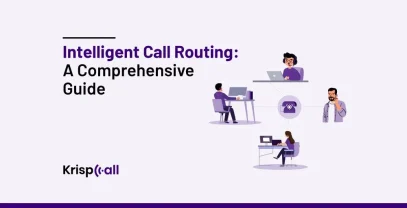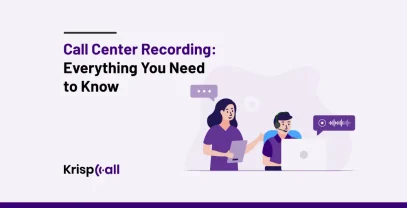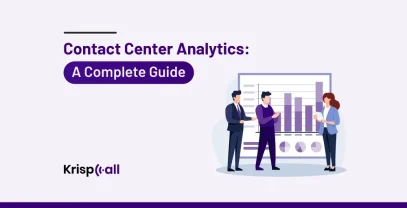You, as an agent, are having a busy day at work and juggling multiple calls but are still doing your best to help every customer. 💡
But then, suddenly, you get a call from an angry customer who raises his or her voice and asks you to talk to your supervisor. This situation is an example of call escalation, and it is a common issue in call centers.
So, what can you do? How can you prevent or handle this situation? This blog will cover everything you need to know from different types of call escalation to methods for handling it proactively and best practices for avoiding or reducing it.
🔑KEY HIGHLIGHTS
- Call escalation means an agent transfers calls to a senior representative when an agent cannot resolve the customer’s issue due to a lack of knowledge and expertise.
- The most common call escalations are hierarchical, functional, and automated.
- Handle call escalations by starting an escalations department, developing an escalation matrix, and finding the teams or individuals.
- KrispCall offers features like IVR call forwarding and call recording, which can help you reduce call escalations.
What is call escalation?
Call escalation is the process of transferring a customer’s calls to a higher-level support like supervisors or managers when a call center agent cannot resolve the customer’s issue for several reasons. It is also known as supervisor escalation or escalation call.

Call escalation is typically caused if an agent struggles to answer the queries properly due to limited knowledge and resources. This situation may result in frustrated customers asking to talk to a supervisor.
So as an agent, you should escalate a call when encountering complicated and sensitive problems, customer dissatisfaction, or issues that require more expertise.
What are the different types of call escalation?
When an agent fails to solve or satisfy a customer’s question, three types of call escalation you can apply: hierarchical, functional, and automatic. We have thoroughly discussed them below.
1. Hierarchical call escalation
Hierarchical call escalation transfers call to a higher level of support within the organizational hierarchy. It is predominantly occurring in terms of transferring calls based on authority, expertise, and decision-making power. For instance, a Tier 1 support agent escalates a call to a Tier 2 support agent with more knowledge of handling problems that Tier 1 agents cannot resolve.
2. Functional call escalation
Functional call escalation transfers phone calls to a team or individual based on their skills or knowledge rather than their seniority within the company. For instance, an agent escalates a call to another agent despite their higher level in the organizational hierarchy, according to their specialized knowledge about a specific product, process, or system.
3. Automatic escalation
Automatic escalation, also known as auto-escalation, is a customer service process that automatically escalates customer complaints or queries to the proper authority or level of support when the starting point of contact cannot resolve them. For instance, if a customer faces a critical software issue, the problem is automatically escalated to an account manager or a department head for prompt resolution.
How do you handle escalation calls proactively?
Handling angry customers’ issues is sometimes challenging, as they act furiously. So, you need to handle escalation calls proactively by following best practices. Here are some of the best tips for handling escalation calls.
Step 1: Start an Escalations Department
An escalations department in a call center is a proactive technique for handling escalation calls. The particular department provides expertise, decision-making authority, and advanced training to handle complicated customer problems. It concentrates on escalated calls to allow for focus on routine inquiries, improving general operations effectively.
Step 2: Develop an Escalation Matrix
Developing an escalation matrix is a proactive approach to handling call escalations effectively. It ensures escalating calls to a suitable level of authority by specifying clear selection paths and responsibilities.
What is a call escalation matrix?
A call escalation matrix is a structured framework that identifies and specifies the responsible individuals or departments at each level and the triggers that prompt each escalation. By following the escalation matrix, businesses can maintain consistency and responsibility.
Step 3: Find the individuals or teams to handle escalations
Get the individuals or teams that can handle escalated calls easily and professionally. It reduces response times and improves customer satisfaction with the right individuals or teams.
How to de-escalate a call in a call center? Call De-Escalation Techniques

Handling frustrated customers is a challenging task. However, there are several techniques you can implement to handle angry customers properly.
Stay Calm
Agents need to stay calm, which sets the professional tone when interacting with a frustrated customer. By remaining calm, call center agents can effectively address complex situations, prevent conflicts, and reassure customers.
It allows agents to listen actively, respond thoughtfully, and guide the conversation with empathy and understanding. It also brings a positive and productive resolution to the customer’s concerns.
Practice Active Listening
Agents must practice active listening, which requires full engagement with the customer, understanding of their concerns, and genuine interest in their issues.
When an agent listens energetically, it shows empathy, builds connections, and creates a supportive environment for the customer. It focuses on the customer’s needs, validates their emotions, and effectively addresses their issues.
Show Empathy to Your Customers
Agents have to empathize with their customers, which involves understanding and acknowledging the customers’ emotions and concerns. By showing empathy, agents can foster a strong relationship with customers.
When an agent displays empathy, it validates the customer’s feelings. It helps customers feel heard, valued and understood and successfully de-escalates the call in a call center.
Use Positive Language
Positive language with customers is a powerful technique to de-escalate calls in a call center. Positive language like ‘yes’ can keep the customer’s perspective positive, minimizing tension.
By asserting positive language, agents can reframe situations from negative to positive and calm angry customers. Furthermore, positive language supports the organization’s reputation and customer satisfaction.
Keep Customers Updated
Keep customers updated about the progress of their issue, updates, or any necessary follow-up steps. It helps to manage expectations, offer transparency, and establish visionary communication.
It lets customers feel supported and informed about their needs, leading to a positive customer experience.
Follow Up With the Customers
The best technique for de-escalation in a call center is following up with customers. This provides timely updates on the progress of issue resolution, which indicates the agent’s accountability, transparency, and commitment to addressing the customer’s concerns.
Moreover, It lets agents provide status update solutions and keep customers engaged throughout the resolution process.
Best practices to prevent or reduce call escalations
- Train and Coach Agents: Training and coaching agents are the best way to prevent or reduce call escalations, developing their skills to handle customer interactions efficiently. It also improves agents’ communication and problem-solving skills, valuing customer satisfaction.
- Upgrade an Internal Knowledge Base: Agents or teams should upgrade their internal knowledge on up-to-date information, troubleshooting guides, and solutions to customer issues. This practice helps empower agents to resolve queries effectively and minimizes the need for escalations to a higher level of support.
- Use Contact Center AI to Enhance Customer Experience: Contact center AI with advanced technologies like Natural language processing and speech recognition analyzes 100% of calls and provides required coaching analytics and performance insights from which call centers can enhance their customer’s experiences.
- Take Advantage of Customer Feedback: Customer feedback helps call centers acquire valuable insights into areas that need improvement. It identifies customer preferences and addresses issues proactively. It helps as a performance indicator for continuous improvement efforts that help diminish call escalations or prevent them.
Handle and Reduce Call Escalations Like Pro with KrispCall
Call centers must improve their operations and customer interactions to handle and reduce call escalations. Features like IVR (Interactive Voice Response), call forwarding and call recording are essential in handling call escalations.

IVR facilitates call routing, minimizes wait times, and ensures customers connect to the right resources. It allows prompt responses by redirecting calls to the right agents, reducing delays, and preventing missed inquiries. The call recording feature also helps with quality assurance, training, and dispute resolution.
Likewise, you want to leverage these features to optimize your organizational customer service, improve efficiency, and reduce call escalations. In that case, you can get them from the best service providers, like KrispCall. It emerges as a valuable solution that leads to a more positive customer experience.
Conclusion
Call escalation involves transferring calls to a higher-level support tier or a senior representative when a call center agent cannot resolve the issue for various reasons. The most common types of call escalation are hierarchical, functional, and automatic. However, you can handle call escalations by starting an escalations department, developing an escalation matrix, and finding the teams or individuals to handle it.
Moreover, agents should stay calm, practice active listening, show empathy to customers, use positive language, keep customers updated, and follow up with them to de-escalate a call in a call center. Call centers can technically handle and reduce call escalations with cloud-based service provider KrispCall.
FAQ
How do you escalate a phone call?
To escalate a phone call, first try to resolve the customer’s issue on your own. Stay calm, try to understand their issues, and offer solutions. But if you struggle to handle the queries properly or if they keep insisting on talking to the supervisor or manager. You can follow the call escalation process.
Before escalating a call, you need to apologize for the inconvenience and the reason you are escalating the call. Place a call on hold and contact your manager or supervisor and explain to them the situation and queries of a customer. If they agree, introduce your customer to the manager or supervisor and thank your customer for their patience and cooperation. Finally, escalate the call.
What are the reasons for call escalation?
The reasons for call escalation are:
- Limited knowledge
- Lack of resources
- Unable to resolve the issue
- Agent’s rude or unprofessional behavior
- The complicated query of the customer





